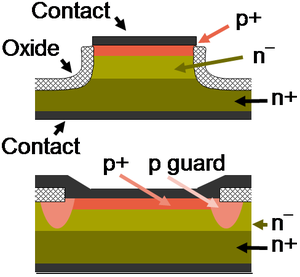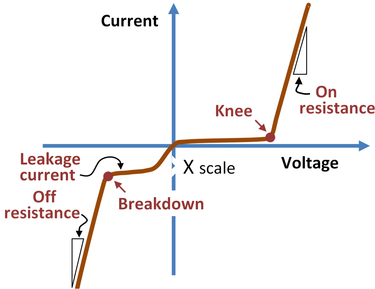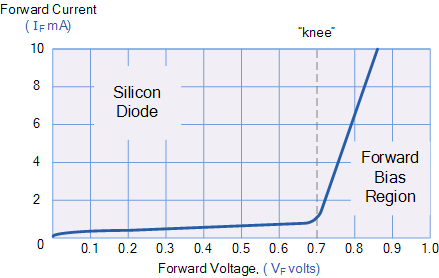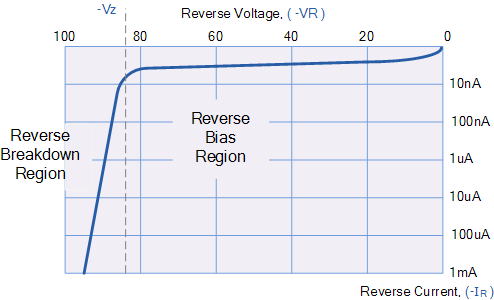A P-N junction diode is one of the simplest semiconductor devices. This diode has the characteristic of passing current in only one direction. It is based on the p-n junction.
Index
What is P-N Junction Diode?
The p-n diode is made by joining a p-type semiconducting layer to an n-type semiconducting layer.

The p-n diode does not have an ideal electric behaviour. In the figure below, it can be seen that the diode conducts appreciable electricity after a non-zero knee voltage (cut-in voltage) is reached.

Knee voltage is the forward voltage at which the current flow increases rapidly. In the reverse direction, the p-n diode conducts a minute leakage current. In the reverse direction, the diode conducts an appreciable amount of electricity, i.e., an appreciable amount of current flow, after the breakdown voltage.
Biasing in P-N Junction Diode
There are three biasing conditions:
- Zero bias – Condition where no external voltage is applied to the diode.
- Reverse bias – Condition where the negative terminal is connected to the p-type and the positive terminal to the n-type of the p-n diode.
- Forward bias – Condition where the negative terminal is connected to the n-type and the positive terminal to the p-type.
The potential barrier in a diode is the barrier that charges cross with the help of additional force. The reverse bias increases the potential barrier in the diode, while the forward bias decreases it.
Forward Bias
In forward bias, holes are injected into the p-type material and electrons are injected into the n-type. The electrons in the n-type are called the majority carriers and electrons that cross the barrier, into the p-type side, are called the minority carriers. The same applies to holes.
A diffusion current (current flowing due to concentration gradient) of holes flows from the p-side to the n-side and a diffusion current of electrons flows from the n-side to the p-side.

This condition represents a low resistance value. Applying forward bias voltage results in the depletion layer becoming very thin and narrow which represents a low impedance path through the junction.
This allows high currents to flow. The point at which there is a sudden increase in current is known as the “knee” point.
Reverse bias
In reverse bias, the external positive voltage applied at the n-side attracts electrons towards it and away from the junction. While the holes in the p-type end are also attracted away from the junction towards the negative electrode.
This results in the wide growth of the depletion layer. This creates an insulator-like environment across the junction.

This condition represents a high resistance value to the P-N junction. Practically, zero current flows through the junction diode, however, a very small reverse leakage current does flow through the junction.
If the reverse bias voltage is increased to a considerably high value, the diode’s p-n junction will overheat and fail due to the avalanche effect around the junction, which causes the diode to short.
Applications of P-N Junction Diode
- The p-n diode can be used as a photodiode when the diode is in a reverse bias state.
- It also finds applications as a solar cell.
- The diode can also be used in LEDs, in the forward bias state.
FAQs
Forward bias is the state in which the negative terminal of external voltage is connected to the p-side of the diode and the positive terminal is connected to the n-side of the diode.
The depletion layer is a thin layer formed between the p and the n sides of the junction, devoid of electrons and holes.
Read More on Diodes
